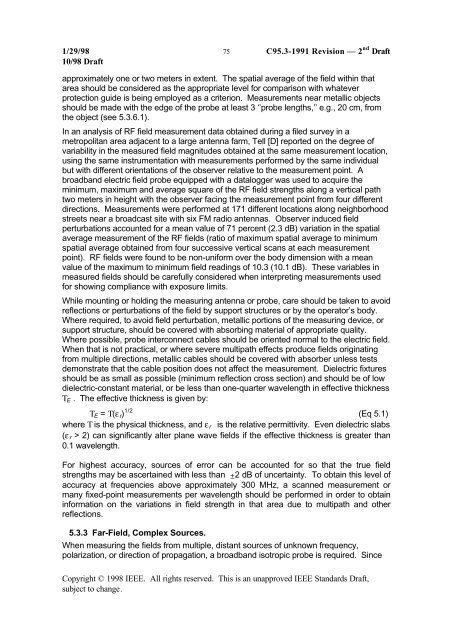DRAFT Recommended Practice for Measurements and ...
DRAFT Recommended Practice for Measurements and ...
DRAFT Recommended Practice for Measurements and ...
You also want an ePaper? Increase the reach of your titles
YUMPU automatically turns print PDFs into web optimized ePapers that Google loves.
1/29/98 75 C95.3-1991 Revision — 2 nd Draft<br />
10/98 Draft<br />
approximately one or two meters in extent. The spatial average of the field within that<br />
area should be considered as the appropriate level <strong>for</strong> comparison with whatever<br />
protection guide is being employed as a criterion. <strong>Measurements</strong> near metallic objects<br />
should be made with the edge of the probe at least 3 ‘’probe lengths,’’ e.g., 20 cm, from<br />
the object (see 5.3.6.1).<br />
In an analysis of RF field measurement data obtained during a filed survey in a<br />
metropolitan area adjacent to a large antenna farm, Tell [D] reported on the degree of<br />
variability in the measured field magnitudes obtained at the same measurement location,<br />
using the same instrumentation with measurements per<strong>for</strong>med by the same individual<br />
but with different orientations of the observer relative to the measurement point. A<br />
broadb<strong>and</strong> electric field probe equipped with a datalogger was used to acquire the<br />
minimum, maximum <strong>and</strong> average square of the RF field strengths along a vertical path<br />
two meters in height with the observer facing the measurement point from four different<br />
directions. <strong>Measurements</strong> were per<strong>for</strong>med at 171 different locations along neighborhood<br />
streets near a broadcast site with six FM radio antennas. Observer induced field<br />
perturbations accounted <strong>for</strong> a mean value of 71 percent (2.3 dB) variation in the spatial<br />
average measurement of the RF fields (ratio of maximum spatial average to minimum<br />
spatial average obtained from four successive vertical scans at each measurement<br />
point). RF fields were found to be non-uni<strong>for</strong>m over the body dimension with a mean<br />
value of the maximum to minimum field readings of 10.3 (10.1 dB). These variables in<br />
measured fields should be carefully considered when interpreting measurements used<br />
<strong>for</strong> showing compliance with exposure limits.<br />
While mounting or holding the measuring antenna or probe, care should be taken to avoid<br />
reflections or perturbations of the field by support structures or by the operator’s body.<br />
Where required, to avoid field perturbation, metallic portions of the measuring device, or<br />
support structure, should be covered with absorbing material of appropriate quality.<br />
Where possible, probe interconnect cables should be oriented normal to the electric field.<br />
When that is not practical, or where severe multipath effects produce fields originating<br />
from multiple directions, metallic cables should be covered with absorber unless tests<br />
demonstrate that the cable position does not affect the measurement. Dielectric fixtures<br />
should be as small as possible (minimum reflection cross section) <strong>and</strong> should be of low<br />
dielectric-constant material, or be less than one-quarter wavelength in effective thickness<br />
Τ E . The effective thickness is given by:<br />
Τ E = Τ(ε r ) 1/2 (Eq 5.1)<br />
where Τ is the physical thickness, <strong>and</strong> ε r is the relative permittivity. Even dielectric slabs<br />
(ε r > 2) can significantly alter plane wave fields if the effective thickness is greater than<br />
0.1 wavelength.<br />
For highest accuracy, sources of error can be accounted <strong>for</strong> so that the true field<br />
strengths may be ascertained with less than ±2 dB of uncertainty. To obtain this level of<br />
accuracy at frequencies above approximately 300 MHz, a scanned measurement or<br />
many fixed-point measurements per wavelength should be per<strong>for</strong>med in order to obtain<br />
in<strong>for</strong>mation on the variations in field strength in that area due to multipath <strong>and</strong> other<br />
reflections.<br />
5.3.3 Far-Field, Complex Sources.<br />
When measuring the fields from multiple, distant sources of unknown frequency,<br />
polarization, or direction of propagation, a broadb<strong>and</strong> isotropic probe is required. Since<br />
Copyright © 1998 IEEE. All rights reserved. This is an unapproved IEEE St<strong>and</strong>ards Draft,<br />
subject to change.
















